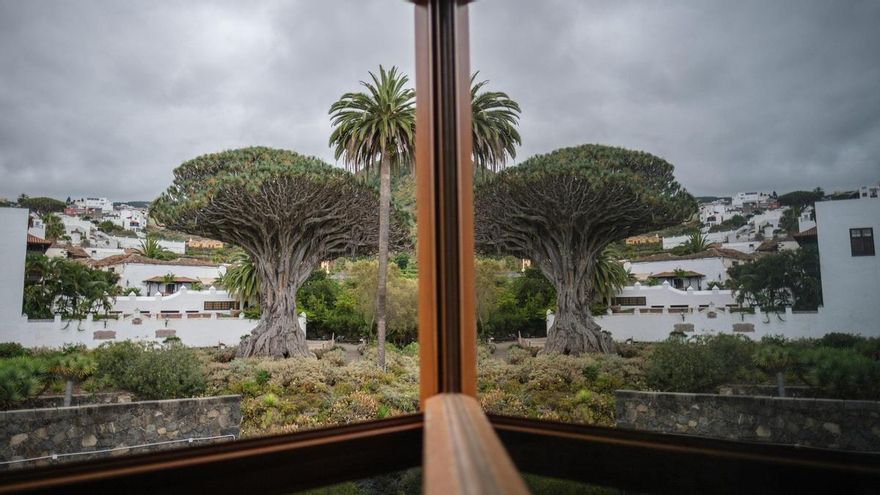
An exhibition commemorates until March 10, 2023 in Santa Cruz de Tenerife the 25th anniversary of the reopening of the dragon parklocated in Icod of the Wines. This project was the result of an international ideas competition held in 1984which the architects won Fernando Menis, Felipe Artengo and Jose Maria Rodríguez Pastrana. His proposal recovered the biodiversity around this natural symbol of the Canary Islandsmoved away the old road and created a large visitor center that today still awaiting final completion.
This exhibition is an initiative of The Tenerife Laboratorylead by fernando menisits titled The Dragon Tree Park, 1998-2023: 25 years involving the mythical and thousand-year-old Dragon Tree of Icod de los Vinos. It is organized within the framework of the Islands of the World project, which in its previous 12 editions was called Islands of the Future. Its objective is to “spread Canarian biodiversity and put cultural and nature tourism back at the center.” It has the support of Canarias Aporta, ProexcaCajaCanarias Foundation, island council, canarian governmentICEX Next, Turismo de Canarias and Institute of Cultural Development.
The exhibition includes current and historical images that explain the project and its evolution. It can be visited from today until March 10, 2023, at number 19 Gómez Landero street, in Santa Cruz de Tenerife. It will open from Monday to Friday from 10:00 a.m. to 2:00 p.m. Soon, its transfer to Icod is also planned.
The organizers recall that «the Dragon Tree of Icod de los Vinos It is the oldest specimen of Dracaena draco, which is preserved in the archipelago. A tree 16 meters high and with a circumference of 20 meters. Endemic species of the Canary Islands, with a slow growth, it has a strong symbolism since in the past it was considered the protector of the islands. However, at the beginning of the 80s of the 20th century, the one who needed protection was precisely the dragon tree. Visitors, around 1 million a year, flocked to see it, and the intense activity that tourism brought around it, endangered his life. We had to stop the visits and find solutions so that the Drago did not die of success ».
«When the concepts of biodiversity and the renaturation of urban environments were beginning to be innovations in scientific congresses, but they were not yet the object of our daily conversations or of articles in the media, in Icod, at the insistence of various biologists and botanists, concerned about the health of the tree, an international ideas contest was called. The winning proposal for the new Parque del Drago was that of a team made up of three young architects (Felipe Artengo, Fernando Menis and José María Rodríguez Pastrana) and, over the years, it would become one of the most important interventions in the Canary Islands in terms of conservation and restoration of biodiversity, in this case a ravine».
«Almost 40 years have passed since we won that international ideas competition, called in 1984, for the creation of a Dragon Tree Park in Icod that would protect it from everything that this specimen had around. Those two decades have only been a moment for the Millenary Drago, while, for us, it has been a work of architecture and landscaping throughout our lives, which has accompanied the architects who devised it throughout our professional lives,” he points out. fernando menis.
The intervention of Artengo, Menis and Pastrana He proposed moving the road so that the dragon tree would once again be protected from pollution and vibrations, separating it from the noise and smoke of the city and returning it to its original habitat. «That’s how it’s always been, growing for centuries behind a wall that separated the farm where it was located from the rest of the municipality. This wall, which had disappeared, was recreated by raising a protective wall that was located in the same place, with the same height and the same material, “the organizers detail.
fernando menis
With a professional career of more than 40 years, Menis’s architectural production includes works of various scales and typologies, as well as long-term research projects. An expert in designing concert halls and auditoriums, he is internationally recognized and awarded for designing an innovative variable acoustic system for the CKK Jordanki Concert Hall (2015, Poland). Among the projects carried out, solo and co-authored: the Church of the Most Holy Redeemer of the Prickly Pear (2022), El Tanque Cultural Space Garden (2022), CKK “Jordanki” Concert and Convention Hall, in Poland (2015). , Plaza Bürchen in Switzerland (2015), Insular Athletics Stadium (2007), Magma Arte & Congresos (2007), Pool in the river Spree in Berlin (2004) and the Headquarters of the Presidency of the Government of the Canary Islands in Tenerife (2000) . Among the projects in progress, the following stand out: the Rehabilitation of the Viera y Clavijo Cultural Park, the Masterplan in Boa Vista, the Pájara Auditorium in Fuerteventura, the Rehabilitation of the Cultural Center in La Guancha, the Rehabilitation of the Teobaldo Power Auditorium in La Orotava. Distinguished in 10 editions with the Manuel de Oráa Canary Islands Architecture Award, Menis also won: the Award for the Best Cultural Building in Poland 2015, from the National Council of Architects of Poland; the CEMEX Award for Universal Accessibility 2016; the 2016 Taipei Design Award for Best Public Building; the Stone Award at the VIII International Stone Architecture Award 2005; and the Prize of the V Spanish Architecture Biennial 1998, among others. Architect PhD from the Polytechnic University of Valencia, his work has been exhibited in several editions of the Venice Architecture Biennale, at the Museum of Modern Art in New York, at the Aedes Berlin gallery and the GA gallery in Tokyo. His project Iglesia del Santísimo Redentor de Las Chumberas is part of the permanent collection of the Museum of Modern Art MoMA in New York.
















